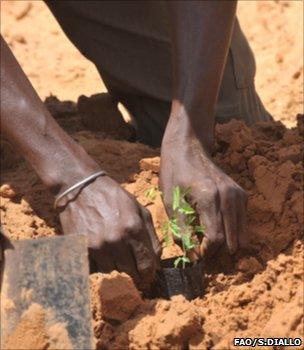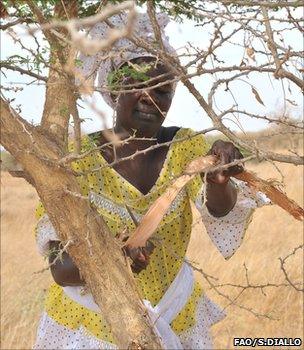UN project shows how trees help halt desertification
- Published

Tree planting can help halt the loss of arable land to the encroaching desert
A UN-led pilot scheme hopes to highlight how trees can help people in arid zone, considered to one of the most hostile habitats on the planet.
The Food and Agriculture Organization (FAO) Acacia project's goal is to show how trees provide, food, fuel, shelter and income during times of hardship.
So far, six nations - including Senegal and Sudan - have hosted tree planting schemes for at-risk communities.
Drylands cover 30% of the Earth's land area, and are found in 100 nations.
"People do not often associate forests with arid areas, yet they are critical in terms of soil protection, mitigating climate change, maintaining biodiversity etc," said Eduardo Rojas, FAO's assistant director general.
"In terms of supporting livelihoods for local communities, forests are very important, " he told BBC News.
Roots of hope
Speaking at the end of the first UN Africa Drylands Week, he added: "Desertification poses a very serious challenge to the world.
"The pace of land degradation and the impact of climate change are threatening food security, exacerbating poverty and impeding sustainable development."

Acacia trees can offer vulnerable villages a steady income, as well as fuel and fodder for animals
Mr Rojas explained that people living in dryland ecosystems were most exposed to this risk, especially rural and pastoral communities.
Globally, an estimated two billion people depend on ecosystems in dry land areas, 90% of whom live in developing countries.
The UN says that about 30% of dry lands are degraded, with particular susceptibility to desertification. In Africa alone, it is feared that two thirds of arable land is expected to be lost in Africa by 2025.
Figures suggest that land degradation accounts for a loss of 3% of agriculture gross domestic product annually in sub-Saharan Africa.
Projections show that more than half of the cultivated agricultural area in Africa could be unusable by the year 2050, leaving the region struggling to feed just 25% of its population.
This was one of the reasons why the FAO had developed the Acacia pilot project, Mr Rojas continued.
"Forests and trees in arid zones are central to understanding the process of desertification - they provide local communities with sustainable livelihoods but also fodder livestock, fuelwood, medicine, timber, resin and gums.

Extracting gum from acacias allow people to earn money from alternative revenue streams
"They are also invaluable for carbon storage and for the provision of clean water and for soil protection."
The project was set up in 2004 with the goal of helping people to plant and manage of acacia forests in an effort to halt desertification, while helping villages in at-risk areas.
As well as providing foliage for animals and fuel for cooking, the trees also produce arabic gum, which is a product that is used in the food and pharmaceuticals industries.
'Funding drought'
Speaking at an event in Dakar, Senegal, Luc Gnacadja - a UN desertification expert - said the inaugural Africa Drylands Week had ended with a very simple, yet stark, message.
He said that it was essential to convince international donors to ensure arid zones would "no longer be 'deserts' of investment".
Mr Gnacadja's calls were backed up by UN secretary general Ban Ki-moon: "The management, conservation and sustainable development of dry forests are central to combating desertification.
"The ongoing greening of the Sahel and other success stories around the world show that degraded lands can be reclaimed by agroforestry and other sustainable practices," Mr Ban added in a statement.
"We need to scale up these interventions and disseminate their results widely."
He said that the UN General Assembly was scheduled to hold a High-Level meeting in September to address the threats from desertification, and he urged the international community to use next year's Rio+20 summit to tackle the problem.
- Published14 June 2011
- Published7 June 2011
- Published18 February 2011
- Published2 February 2011
- Published3 August 2010